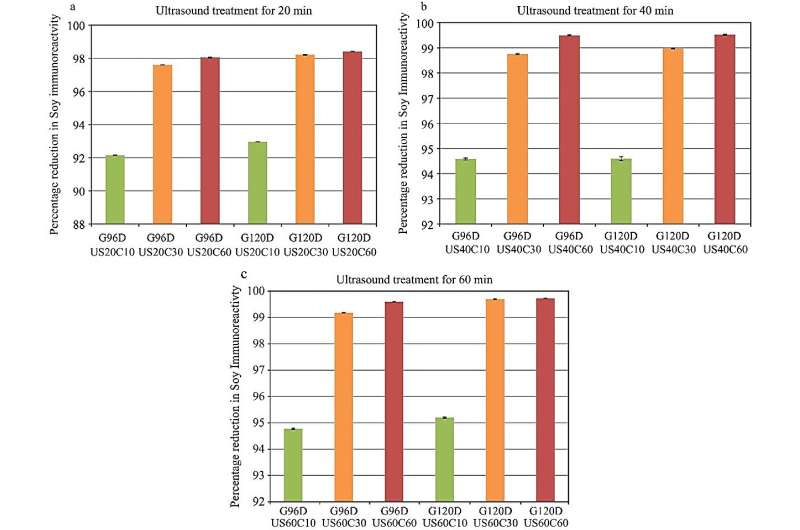This article has been reviewed according to Science X's editorial process and policies. Editors have highlighted the following attributes while ensuring the content's credibility:
fact-checked
proofread
Research highlights novel approach to diminish soy allergen immunoreactivity

Soybeans, a major source of protein for millions globally, is one of the leading foods causing allergies. According to the World Health Organization, there are eight allergenic fractions in soybeans, with β-conglycinin and glycinin being the major concern.
Given that more than 90% of food allergenic reactions are caused by soy allergens, there is an urgent need to reduce the immunoreactivity (IR). This challenge is further exacerbated by the thermal-resistant treatment denaturation of many soy proteins, especially commercial soy protein isolate (SPI), which is of significant concern to individuals exhibiting soy allergenic sensitivities.
In a study published in Food Innovation and Advances, researchers investigated the combined effects of germination, ultrasound sonication, and traditional cooking on reducing the IR of soy allergens. The paper is titled, "Effect of sonication-cooking on the immunoreactivity of soy slurry from germinated soybeans."
Raw soy slurry samples began with an IR of 377 mg/L. After 96 and 120 hours of germination and subsequent 60-minute ultrasound treatment, a significant reduction to 189 mg/L and 192 mg/L in IR was observed, translating to a 50% decrement. Ultrasonic treatment time is linearly related to allergenic protein IR.
By augmenting this process with traditional cooking, the reduction potential was amplified, attributed to ultrasound's enhancement of soy proteins' emulsifying properties and altered the structure and aggregation properties. The pinnacle of these treatments was observed when a soy sample treated with 60 minutes of ultrasound plus subjected to 60 minutes of cooking, leading to an overwhelming IR reduction of 99.9%. Contrarily, the mere act of cooking for an equivalent duration could only muster a 97% reduction.
A log-cycle evaluation emphasized the effect of the combined treatments, achieving an IR reduction of 2.57 log cycle. Furthermore, the combined germination and sonication procedures have proven to diminish anti-nutritional properties and amplify the phenolic and radical scavenging activity by more than 50%.
In conclusion, the integrated approach of germination, sonication, and cooking not only provides a safer alternative to soy consumption for allergen-sensitized person, but also enhances the nutritional value of soy. The actual amount of residual allergen that causes sensitization may vary depending on an individual's sensitivity to the allergen, so further testing of animal or human effects on sensitization is necessary. However, the processing concept of reducing allergen concentrations to low levels is a step in the right direction for further research on allergenicity.
More information: Akshaya Ravindran et al, Effect of sonication-cooking on the immunoreactivity of soy slurry from germinated soybeans, Food Innovation and Advances (2023). DOI: 10.48130/FIA-2023-0008





















